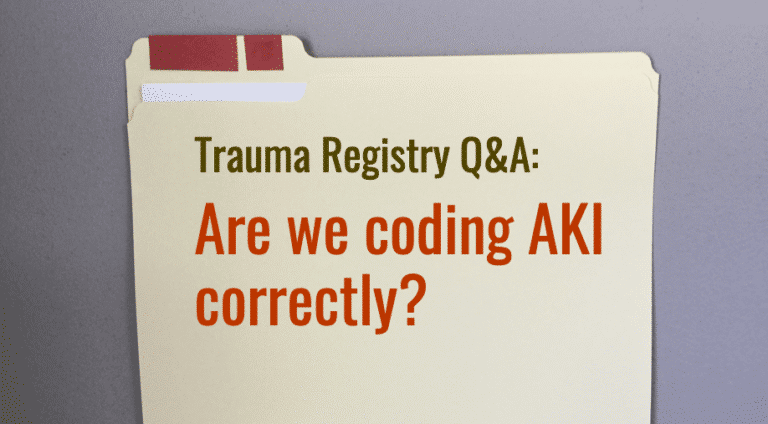Acute kidney injury (AKI) is an abrupt decrease in kidney function. AKIs can result from traumatic injury, but according to the National Trauma Data Standard (NTDS) Data Dictionary not all AKIs should be included in the trauma registry.
In this month’s Trauma Registry Q&A column, data experts from Pomphrey Consulting explain the pitfalls of kidney injury documentation and the correct way to evaluate an AKI for registry inclusion.
Q. What is the main pitfall to avoid when dealing with an AKI?
AKIs are typically documented in the history and physical or other physician notes. However, it is important to realize that AKIs documented for billing purposes may or may not meet NTDS inclusion criteria. According to the NTDS, only stage 3 AKIs should be recorded in the trauma registry.
Q. What problems can happen when other AKIs are entered in the registry?
Inaccurate AKI data in a trauma registry will paint an inaccurate picture of your trauma center’s patient population. We recently worked in a hospital where registrars were improperly including all AKIs (stages 1, 2 and 3) in the trauma registry. Since this hospital participated in the Trauma Quality Improvement Program (TQIP), the center was a very high outlier for acute kidney injury. In cases like this, trauma program leaders may incorrectly flag AKI care as an opportunity for improvement, potentially wasting organizational resources.
Q. How do you know if an AKI is a stage 3 injury?
The NTDS requirements for AKI are based on the severity staging system developed by the Kidney Disease: Improving Global Outcomes (KDIGO) foundation. An AKI qualifies as stage 3 if any one of the following are present:
- Serum creatinine is 3 times the baseline
- Increase in serum creatinine to ≥ 4.0 mg/dl (≥ 353.6 μmol/l)
- Initiation of renal replacement therapy
- In patients less than 18 years old, decrease in estimated glomerular filtration rate (eGFR) to <35 ml/min per 1.73 m²
- Urine output < 0.3 ml/kg/h for > 24 hours
- Anuria for > 12 hours
Note that the presence of any one of these triggers will automatically qualify the AKI as a stage 3 injury.
Q. Where is this information found?
Much of the information needed to identify AKI can be found in the history and physical, progress notes, consultant notes or discharge summary. Serum creatinine values can often be found in the lab section of the electronic medical record. Urine output values can typically be found in nursing notes.
Q. What is an effective way to make sure registrars evaluate AKIs correctly?
Some trauma centers have created an AKI decision template based on the six triggers listed above. This could be structured as a simple worksheet with spaces for filling in key lab values. The registrar or PI nurse goes through the worksheet step by step. As soon as the user gets to a “yes,” he or she can stop and confidently code the injury as a stage 3 AKI.
This Trauma Registry Q&A was produced in partnership with Pomphrey Consulting, a comprehensive trauma registry company that provides training and registry management services. The American College of Surgeons has recognized the company’s Trauma Registrar Mentorship Program for meeting the trauma registrar course requirement of CD 15-7. The course is revised each year to meet all NTDB changes and reflect the demands of the ever-changing world of trauma registry. It also includes full training in ICD-10-CM and ICD-10-PCS. For more information, visit the Pomphrey Consulting website.

